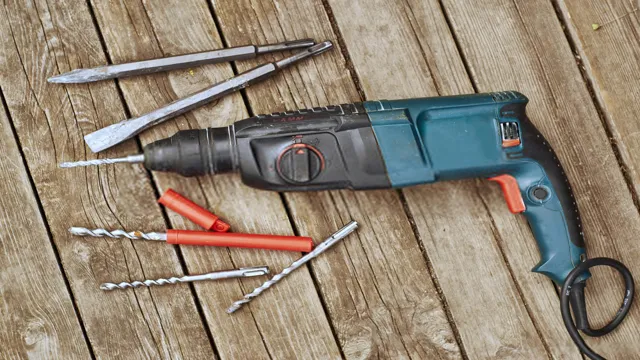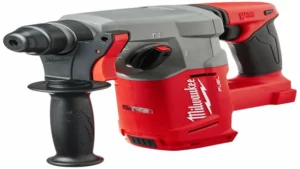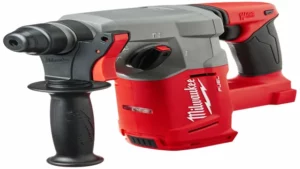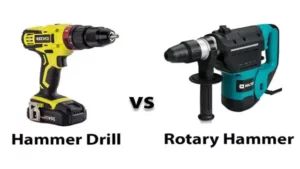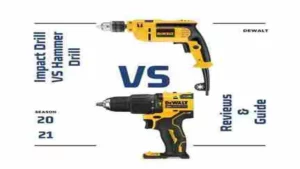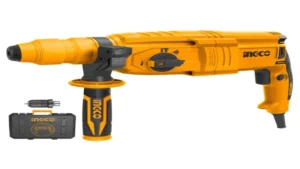Looking to tackle a big renovation project or trying to break up some stubborn concrete? Then you might want to consider investing in a rotary hammer or a demolition hammer, depending on the task at hand. While both of these tools may look somewhat similar, they have some key differences that can make a big impact on their effectiveness. But what exactly sets these hammers apart? In this blog, we’ll break down the differences between rotary hammers and demolition hammers, so you can make an informed decision and achieve maximum results.
Overview
Are you confused about the difference between a rotary hammer and a demolition hammer? While both may look similar, they are designed for different purposes. A rotary hammer is a versatile tool that can handle a variety of tasks, such as drilling through hard materials like concrete or stone. It uses a piston mechanism that creates a rapid hammering action and can be used to both drill and chisel.
On the other hand, a demolition hammer is designed specifically for demolition work. It has a more powerful motor and uses multiple chisel bits to break through thick concrete or masonry walls. While a rotary hammer can be used for light demolition work, a demolition hammer is better suited for heavy-duty demolition tasks.
In summary, the key difference between the two tools is their intended use: rotary hammers are great for drilling and chiseling while a demolition hammer should be used for heavy-duty demolition work.
Defining Rotary Hammer
A rotary hammer is a powerful tool used for drilling and chiseling tasks in construction and demolition projects. It is a type of hammer drill that provides a more significant impact force and speed than traditional ones, making it ideal for heavy-duty applications. The rotary hammer uses a piston mechanism, which provides the banging action and delivers a tremendous amount of energy to the drill bit.
This tool comes in different sizes, ranging from small to heavy-duty models with various accessories to fit different tasks. One of the main advantages of a rotary hammer is its ability to work on challenging materials such as concrete and stone, which are usually difficult to drill into using typical drills. It is an essential tool for professionals in the construction and renovation industry, capable of making their jobs easier and more efficient.
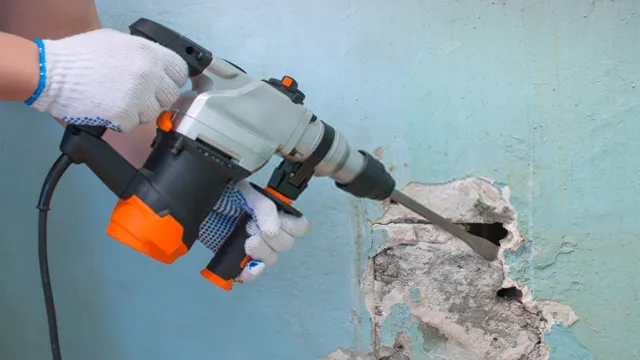
Defining Demolition Hammer
A demolition hammer is a powerful tool designed to break through hard surfaces like concrete and brick walls. It is commonly used in construction, renovation, and repair projects where the removal of tough materials must be done without damaging the surrounding areas. Demolition hammers come in a variety of sizes and shapes, each with its own set of advantages and disadvantages.
Some use electric or hydraulic power sources, while others are pneumatic or gas-powered. The size and power of a demolition hammer will depend on the project’s scope, as larger hammers are required for bigger jobs. When selecting a demolition hammer, it is essential to consider factors like weight, portability, and ease of use, as well as the type of surface to be demolished.
With the right tool, demolishing tough materials can be made safer, faster, and more efficient.
Performance
When it comes to power tools, there can be confusion between similar-looking machines that serve different purposes, such as rotary hammers and demolition hammers. While both may look similar, their functions are different. Rotary hammers are designed for drilling into tough materials like concrete, whereas demolition hammers are designed for destroying structures or taking apart masonry.
The main difference between the two is in their performance. Rotary hammers are known for their speed and precision, while demolition hammers are known for their raw power and ability to deliver heavy blows. The latter is ideal for projects that require breaking up materials into smaller pieces or removing stubborn tiles.
In contrast, rotary hammers are better suited for drilling clean and precise holes. Although there are some similarities between the two, it’s important to understand their differences in order to choose the right tool for the job at hand.
Rotary Hammer Performance
Rotary hammer performance is essential in any construction project, as it directly affects the speed and quality of work. Generally, the performance of a rotary hammer is determined by its power, speed, and impact force. The power of a rotary hammer is measured in watts or volts, and it ranges from 500 to 1500 watts or 12 to 36 volts.
The higher the power, the greater the drilling capacity. The speed of a rotary hammer is measured in rotations per minute (RPM), and it ranges from 1000 to 4000 RPM. The higher the speed, the faster the drilling process.
The impact force of a rotary hammer is measured in joules and determines the strength of the hammering action. The higher the joule rating, the more powerful the impact force, resulting in faster and more efficient drilling. Overall, selecting a rotary hammer with optimal power, speed, and impact force, based on the project requirements, ensures satisfactory performance and productivity.
Demolition Hammer Performance
When it comes to demolition hammer performance, there are a few things to keep in mind. First and foremost, the power of the hammer is key. Look for a model with a high wattage or amp rating, as this indicates a more powerful motor and harder hitting action.
Additionally, be sure to consider the weight and balance of the hammer, especially if you’ll be using it for long periods of time. A well-balanced hammer can reduce fatigue, allowing you to work more efficiently. Finally, think about the type of jobs you’ll be using the hammer for.
If you’ll be working on concrete or masonry, look for a hammer with a high impact energy rating, as this will help you break through tough materials quickly and effectively. With a little bit of research and consideration, you can find a demolition hammer that meets all your performance needs and helps you complete your projects with ease.
Types of Applications
When it comes to software applications, performance is a crucial aspect that cannot be ignored. Performance is related to the speed and responsiveness of an application, and it affects the user experience and the overall success of the application. High-performance applications are those that can handle large amounts of data quickly and efficiently while providing a seamless user experience.
These applications are typically designed for tasks such as data analysis, simulation, and gaming, where speed and responsiveness are of utmost importance. To achieve high performance, developers use various techniques, including optimization, caching, and parallelization. The keyword “performance” is critical in this context, as it represents the primary factor that differentiates high-performance applications from their slower counterparts.
Therefore, application developers must focus on optimizing their software to ensure high performance, enabling users to get the most out of their applications.
Size and Weight
When it comes to choosing between a rotary hammer and demolition hammer, size and weight are important factors to consider. A rotary hammer is usually smaller and lighter than a demolition hammer, making it easier to handle and maneuver. This makes it a great choice if you need to work in tight spaces or carry the tool around for extended periods of time.
On the other hand, a demolition hammer is larger and heavier, meaning that it packs a more powerful punch. This makes it ideal for heavy-duty jobs like breaking up concrete or removing tiles. However, its larger size and weight can make it harder to use for extended periods of time or in tight spaces.
Ultimately, the choice between a rotary hammer and demolition hammer will depend on the specific job you need to do and your own personal preferences.
Rotary Hammer Size and Weight
When it comes to choosing the right rotary hammer, size and weight are important factors to consider. The size of the rotary hammer determines the amount of power it can deliver, as well as its versatility and maneuverability. A larger rotary hammer will generally be more powerful, but can also be heavier and more difficult to handle.
On the other hand, a smaller rotary hammer is more lightweight and easy to maneuver, but may not have as much power as a larger model. The weight of the rotary hammer is also an important consideration, especially if you are going to be using it for extended periods of time. A heavier rotary hammer can be more difficult to hold and control, and can cause fatigue in your arms and shoulders.
On the other hand, a lighter rotary hammer can be easier to hold and maneuver, but may not be as durable or powerful as a heavier model. When choosing a rotary hammer, it’s important to find a balance between size and weight that works best for your needs. Think about the type of work you will be doing, the amount of power you require, and how long you will be using the tool.
By taking these factors into consideration, you can choose a rotary hammer that is both powerful and easy to use. So, whether you’re a professional contractor or a DIY enthusiast, finding the right size and weight for your rotary hammer can help you get the job done quickly and efficiently.
Demolition Hammer Size and Weight
When it comes to selecting the right demolition hammer, size and weight are two essential factors that you should consider. The size of a hammer is primarily measured by the power of its motor and the length of its bit. Smaller hammers are suitable for light to medium-duty work, while larger hammers are ideal for more extensive and heavy-duty jobs.
The weight of the hammer also plays a crucial role in its performance, as heavy hammers convey more force but can be challenging to maneuver for extended periods. Similarly, lighter hammers are effortless to handle and maneuver but may not convey as much force as heavier models. Generally, the size and weight of a demolition hammer should correlate with the type of task you intend to accomplish.
A heavier and more potent hammer would be suitable for breaking concrete, asphalt, or other tough surfaces, while a lighter hammer would be appropriate for removing tiles or plaster. Therefore, it’s essential to consider the size and weight of the hammer before making your purchase to ensure you get the right tool for the job.
Accessories
When it comes to power tools, it’s essential to know the difference between similar-looking but functionally different devices. One such example is a rotary hammer and a demolition hammer. While they may look alike, they each serve a unique purpose.
A rotary hammer is a powerful drill that can bore holes through thick concrete walls and slabs. It has a hammering function that helps it break up harder materials, and it’s used for construction purposes. On the other hand, a demolition hammer is a tool used to demolish concrete structures, pavements, and roads.
It’s significantly more powerful than a rotary hammer, and it’s used for breaking up large concrete structures. Both are effective in their own way, but they are constructed for different purposes. So, when deciding which tool you need, it’s best to consider the nature of your project and choose the tool that best suits your needs.
Rotary Hammer Accessories
Rotary hammer accessories are essential for both DIY enthusiasts and professional workers. These accessories are designed to enhance the functionality of a rotary hammer, making it more versatile and efficient. Some of the most common accessories for a rotary hammer include chisels, drill bits, and dust collection systems.
Chisels are used for breaking and chipping away at concrete or masonry, while drill bits are used for drilling through these materials. Dust collection systems, on the other hand, are used for keeping the work area clean and safe by capturing dust and debris as they are generated. Other accessories include depth stops, lubricants, and carrying cases.
Depth stops are used to ensure that holes are drilled to the proper depth, while lubricants help to extend the life of the rotary hammer and ensure smooth operation. Carrying cases are also essential for transporting rotary hammer accessories and keeping them organized. Overall, rotary hammer accessories are an important investment for anyone who works with concrete or masonry.
By using these accessories, you can increase productivity, save time and money, and ensure that your work is of the highest quality.
Demolition Hammer Accessories
If you’re looking to get the most out of your demolition hammer, it’s crucial to have the right accessories on hand. There are a variety of accessories available that can help make your job easier and more efficient. One common accessory is the chisel, which is essential for breaking apart concrete and other materials.
You can choose from a variety of chisel types, including flat and point chisels, depending on the type of work you’re doing. Additionally, if you’re working in an area with a lot of dust or debris, a dust extraction system is a must-have accessory. This will help keep the air clean and make the work area safer.
Other accessories to consider include grease guns to keep your demolition hammer lubricated, replacement bits for when your current ones wear down, and storage cases to keep everything organized and easily transportable. When choosing accessories for your demolition hammer, make sure to choose high-quality products that are compatible with your specific model. With the right accessories, you’ll be able to tackle any demolition job with ease.
Conclusion
In conclusion, the difference between a rotary hammer and a demolition hammer is like the difference between a scalpel and a sledgehammer. While both tools can be used for demolishing concrete structures, the rotary hammer is designed to make precise, controlled holes while the demolition hammer is meant to crack and break up larger areas. In other words, the rotary hammer is the delicate and precise tool of a skilled surgeon, while the demolition hammer is the brute force choice of a demolition expert.
So, depending on your needs, choose your tool wisely, and remember: not every job requires a heavy hand – sometimes it’s the finesse that counts.”
FAQs
What is a rotary hammer?
A rotary hammer is a power tool that combines a hammering function with a rotating drill bit for drilling into tough materials like concrete.
What is a demolition hammer?
A demolition hammer is a heavier-duty power tool used for breaking down concrete and other tough materials.
What is the difference between a rotary hammer and a demolition hammer?
The main difference is their intended use: a rotary hammer is primarily used for drilling into tough materials, while a demolition hammer is primarily used for breaking down tough materials.
Can a rotary hammer be used as a demolition hammer?
While a rotary hammer can be used to break down softer materials like brick or tile, it is not recommended to use it as a demolition hammer for tougher materials like concrete.
What kind of bits can be used with a rotary hammer?
Rotary hammers typically use SDS-Plus or SDS-Max bits, which are designed for heavy-duty drilling in tough materials.
What kind of bits can be used with a demolition hammer?
Demolition hammers typically use chisels or points, which are designed for breaking apart tough materials.
Which one is better for a DIY project: a rotary hammer or a demolition hammer?
It depends on the specific project and materials involved. For drilling into tough materials like concrete, a rotary hammer would be more suitable. For breaking down concrete or other tough materials, a demolition hammer would be more suitable.
